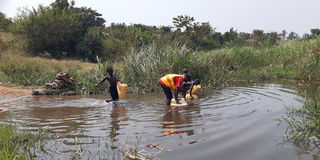Kalangala residents decry lack of clean and safe water

Residents fetch water at one of the swamps in Kirugu Mukelu Village in Mazinga Sub-county, Kalangala District, at the weekend. PHOTOS/ SLYVESTER SSEMUGENYI.
What you need to know:
- Out of the 64 islands that make up the district, only two islands (Buggala and Bukasa) have access to safe and clean water.
Despite being located on Lake Victoria, access to clean and safe water is a distant dream to many of the residents in the island district of Kalangala.
Comprising 64 inhabited islands, Kalangala District has only two islands (Buggala and Bukasa) where residents have access to clean and safe water.
The rest of the population draws water directly from the lake or unprotected ponds, which exposes them to hygiene-related diseases such as cholera, typhoid and dysentery.
Mr Stephen Lukwago, the chairperson of Lujaabwa Landing Site on Mazinga Island, said the boreholes the district budgeted for this financial year have not been drilled yet it is only three months left until the end of the financial year.
“We send our children to collect water from distant swamps, which is time wasting and dangerous,” Mr Lukwango told Daily Monitor at the weekend.
Cases of crocodiles attacking residents in search of water in swamps in the area are common.
In 2017, the government rolled out the Safe Rural Water project in six landing sites of Bufumira, Lulamba, Sserinya, Kachanga, Buyovu and Ssemawundo, but the project suffered a stillbirth.
In this project, the district reportedly lost about Shs270m since the installed water pump could not adequately serve the targeted four nearby villages of Lulindi Bufumira, Buwunge and Misenyi.
Ms Proscovia Nakitende, a resident of Sserinya Landing Site, said: “We are surrounded by water, but accessing clean water is a nightmare. We just drink what is available and life moves on.”
Some of the islands where residents lack clean water include Ntuuwa, Lujaabwa, Miyana, Nkese Bubeke, Gunga, Kilugu Mukelo, Butulume, Buyigi and Kachungwa in Mazinga and Bubeke sub-counties.
Even on Bugala main island where clean water is available, out of the 19 villages, only 10 are covered.
Mr Rajab Ssemakula, the Kalangala District chairperson, said their plan to have a borehole at every landing site, especially those with a population above 2,000 people, is still on.
“We regret that many of our people cannot access clean water. Our plan is to dig three boreholes every financial year for a period of five years, but lack of funds has slowed down this programme,” he said in a telephone interview yesterday
Background
Access to clean water
Available records from the Ministry of Water show that Uganda failed to attain the access to clean water target in rural areas as planned in the Water and Environment Development Sector Plan 2015/2016 to 2019/2020.
The plan had targeted 79 percent clean water access from boreholes in rural areas, but only 68.7 percent was attained between 2016 and 2020. This was attributed to inadequate functional boreholes in rural areas.
Out of the 60,000 boreholes constructed across the country, 12,000 are not functional and the government is capable of repairing only 40 percent of those boreholes that break down.
To match the borehole breakdown with the rate of repairs made, the government needs Shs100b per year, according to Mr Alfred Okot Okidi, the Permanent Secretary in the Ministry of Water.
A total of seven million Ugandans lack access to safe water and 28 million do not have access to improved sanitation facilities.




